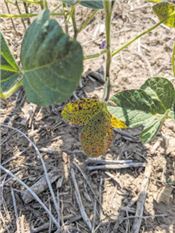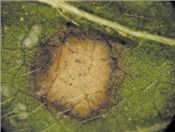|
Update On Foliar Diseases Of Soybean
DR. CARL A. BRADLEY
PRINCETON, KY.
As the rains fall, environmental conditions become favorable for leaf diseases of soybean. Currently, there are a couple of foliar diseases of soybean that can be observed in fields in Kentucky, which are Septoria brown spot and Phyllosticta leaf spot.
Septoria Brown Spot
Septoria brown spot is caused by the fungus Septoria glycines. It is a very common disease of soybean in Kentucky and surrounding states. This disease generally can easily be found in fields that have been planted to soybean in consecutive years (no rotational crop in between soybean crops). This disease is always found on the lowest leaves first, and can currently be observed in some of my research trials in Princeton, KY. When it rains, spores of the fungus are splashed from soybean residue on the ground onto the lowest leaves of soybean plants. Infection causes small dark spots on soybean.
Later on, these spots may coalesce, and yellowing may occur around the spots and across entire leaves (Figure 1). This disease generally is not economically important unless frequent rainfall occurs throughout the season. When it rains, spores on infected leaves, may splash onto the leaves above them, which causes the disease to progress from the bottom of the plant to the top of the plant when rainfall occurs throughout the season. If the disease does make it to the top of the soybean canopy late in the season, it is possible that some yield losses may occur. While soybean plants are still in the vegetative stages (before flowering), there is no need to spray a fungicide to manage Septoria brown spot.
Phyllosticta Leaf Spot
Phyllosticta leaf spot (caused by Phyllosticta sojicola) is another fungal disease that has been observed in a few fields in western Kentucky recently. Although the economic risk of this disease is very low, its symptoms resemble those caused by frogeye leaf spot, which can be an economically important disease. Generally, Phyllosticta tends to show up a little earlier in the season than frogeye leaf spot, which usually doesn’t appear until plants are in reproductive stages (flowering, pod development, etc.) and the leaf canopy has closed between rows. Symptoms of Phyllosticta leaf spot do not always resemble frogeye leaf spot, but sometimes can.
Symptoms of Phyllosticta leaf spot can appear as somewhat round, light to tan colored lesions with a dark border around them. Structures known as “pycnidia” will form inside the lesions. These pycnidia can be visible to the naked eye and appear as dark-colored “specks” in the lesions (Figure 2). Phyllosticta leaf spot is not considered to be an economic threat to soybean grown in Kentucky. Symptoms of this disease can occur earlier in the season than when we would typically observe frogeye leaf spot, so it is important to recognize and differentiate these two diseases. More information on how to distinguish between frogeye leaf spot and other “look-alike” diseases, including Phyllosticta leaf spot, is available in the publication, Frogeye Leaf Spot on the Crop Protection Network website. ∆
DR. CARL A. BRADLEY: Plant Pathology Extension Specialist, University of Kentucky

Figure 1. Septoria brown spot affecting lower leaves of a soybean plant.
Photo: Carl Bradley, UK

Figure 2. Phyllosticta leaf spot on soybean (magnified). Note dark “specks” (pycnidia) in the center of the spot.
Photo: Brenda Kennedy, UK
|
|